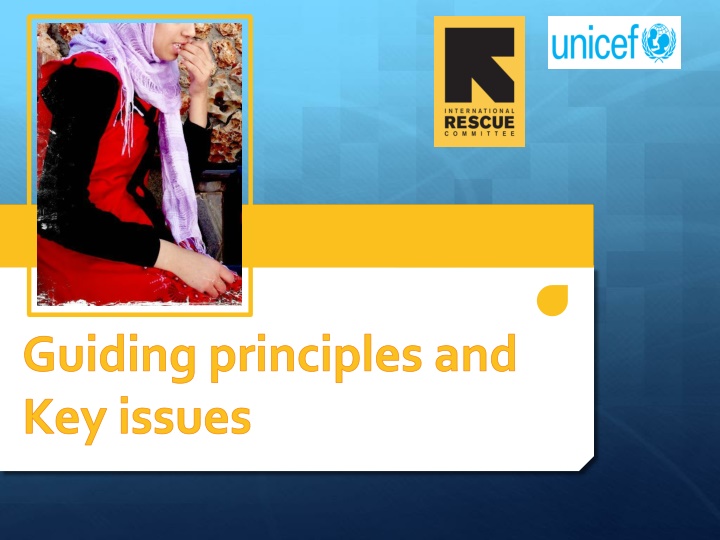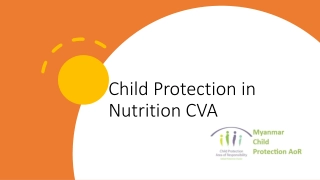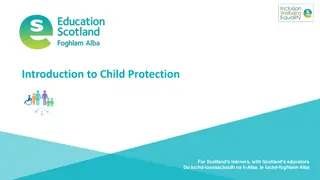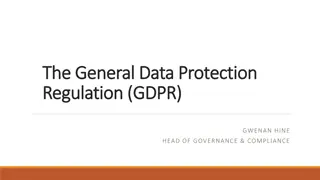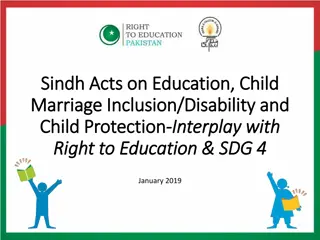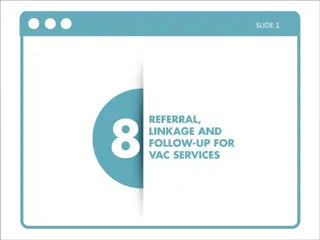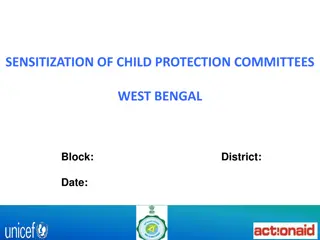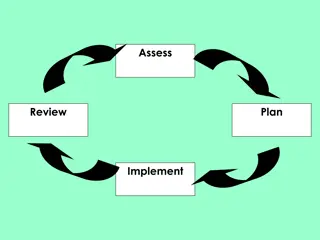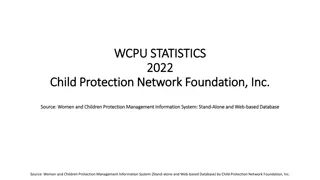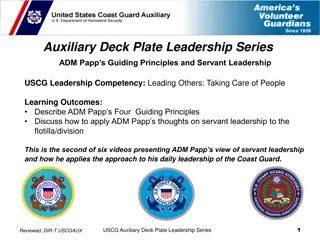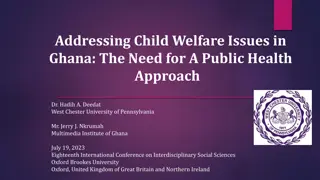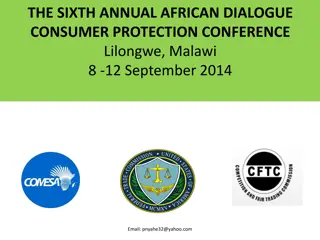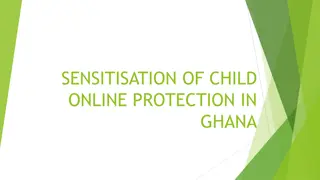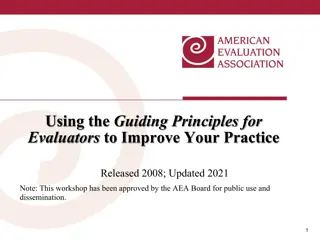Child Protection Guiding Principles and Key Issues
Explore the guiding principles and key issues in child protection, including mandatory reporting, confidentiality protocols, and ensuring the best interest of the child. Learn about fundamental principles such as safety, confidentiality, and empowerment, along with key challenges in implementation. Engage in activities like the telephone whisper game to understand communication challenges. Enhance your understanding of best practices for reporting child abuse and the importance of organizational procedures in maintaining discretion and confidentiality.
Uploaded on Oct 06, 2024 | 0 Views
Download Presentation

Please find below an Image/Link to download the presentation.
The content on the website is provided AS IS for your information and personal use only. It may not be sold, licensed, or shared on other websites without obtaining consent from the author.If you encounter any issues during the download, it is possible that the publisher has removed the file from their server.
You are allowed to download the files provided on this website for personal or commercial use, subject to the condition that they are used lawfully. All files are the property of their respective owners.
The content on the website is provided AS IS for your information and personal use only. It may not be sold, licensed, or shared on other websites without obtaining consent from the author.
E N D
Presentation Transcript
INSERT PHOTO Guiding principles and Key issues
Session outline Guiding principles & issues activity I Outline of 7 guiding principles Outline of 3 key issues Challenges in implementation Guiding principles & issues activity II
Broken telephone / whisper down the lane
Telephone / whisper activity Form a line, with all participants The first participant is given a secret message by the facilitator They must whisper the message to the person next to them The message must pass the length of the line Each person gives the message only once The last person must say the message they heard out loud to all
Seven guiding principles
7 guiding principles S Safety of the child C Confidentiality C Comfort the child B Best Interest R Resiliency & empowerment E Equality & fairness I Involve child in decision-making Mnemonic: Small Children Can Be Really Energetic & Imaginative
3 key issues Mandatory reporting Confidentiality protocols Ensuring best interest of the child: balancing roles in decision-making
Key issue 1: Mandatory Reporting Refers to state laws & policies which mandate certain agencies &/or persons in helping professions (teachers, social workers, health staff, etc.) to report actual or suspected child abuse
Best practice for reporting Organizational procedures to guide & ensure: Discretion & confidentiality Knowing criteria for mandatory reporting Verbal / written report within timeframe Report minimum essential information Explaining to child, caregiver &/or family Documenting report Best practice page 92
Maintaining best interests in mandatory reporting Mandatory reporting can raise safety and ethical concerns, esp. in emergency. May not always be in child s best interests DO YOU KNOW ANY EXAMPLES OF SITUATIONS WHERE REPORTING CAN PUT A CHILD AT RISK?
Best interests guides decision making on reporting when Authorities lack clear procedures & guidelines for reporting Lack protection & legal support to respond suitably Reporting could risk child s safety Consult with supervisor. Consider safety, then legal implications Guidance on decision making page 93 / 94
Key issue 2: Confidentiality Conditions under which information revealed by an individual in a relationship of trust will not be disclosed to others WHY DO YOU THINK CONFIDENTIALITY IS IMPORTANT FOR CHILD SURVIVORS?
Why confidentiality is important An ethical principle - matter of best practice Ensure safety & security for survivors Breach of confidentiality may have negative effects stigma, retaliation, false accusation on the lives of survivors & / or other people involved HOW DO YOU THINK WE ENSURE CONFIDENTIALITY?
How to maintain confidentiality Requires that collect information in safe ways Protect all information gathered about survivors Agree to share only after gaining explicit permission (informed consent) & only with those acting to help the child There are limits to confidentiality IN WHAT SITUATIONS DO YOU THINK WE NEED TO BREAK CONFIDENTIALITY?
Exceptions to confidentiality DANGER LEGISLATION Mandatory laws or policies require that service providers (individuals or agencies) report all cases identified Child is at risk of serious harm by another person Child is at risk of harming him/herself or someone else Child s life is in danger
Explaining limits to confidentiality Service providers explain limits of confidentiality in way that respects dignity Communicate depending on age and development stage of individual child Include child in decision making process Communicate limits to confidentiality during informed consent procedures Sample scripts page 97
Key issue 3: Best interests of the child A principle to assist in process of determining choices to be made that ensure well-being of a child or children A primary consideration in all actions affecting children
Actions promoting best interest ensure Protection of child from further harm Child s wants & needs taken into account Children and families empowered Benefits & potential harm examined and weighed up Recovery & healing
Best interest & decision making Legally parents & guardians have right to make decisions on behalf of child Situations where caregiver absent or their actions may compromise wellbeing of child: - Parent / guardian involved in abuse - May demonstrate harmful reactions - Child does not want parent to know - Child is separated / unaccompanied Steps to guide decision making for best interest page 100
Childs role in decision making Age Decision making 15 + mature enough to make their own decisions 13 14 presumed to be mature enough to make a major contribution to decisions 9 12 meaningfully participate in the decision-making process, but maturity must be assessed on an individual basis < 9 right to give their opinion & be heard. May be able to participate in decision-making to a degree. Caution advised to avoid burdening them with decisions beyond their ability to understand
What are the key challenges in implementing principles and issues in your context?
Common challenges Mandatory reporting: - Lack of appropriately trained service providers - Risks for child when reporting Confidentiality: - Culture of community awareness of private issues - Lack of facilities & resources Best interest: - Cultural response to abuse may be further form of abuse - The concept of asking children for their ideas and opinions may not be considered valuable or culturally appropriate.
Broken telephone / whisper down the lane
Telephone / whisper activity Half participants form a line, and pass secret message along the line, as before The other half of participants must try to hear the message being passed along At the end - Those not in the line must say if they managed to hear anything. IF so what did they hear? - The last person in the line must say the message they heard out loud to all
Debrief questions In this setting When and how did the message change? How does this activity relate to the subject of the session we have just had? How did it feel for those in the line to have others trying to hear the message? How was it different the 2nd time versus the 1st time they did the activity?
Key points Guiding principles established to ensure all actors accountable to minimum standards for behavior & action Agencies offering CCS must have supervision systems & staff training programs Service providers apply guiding principles in different ways, at different times, based on specific situation
